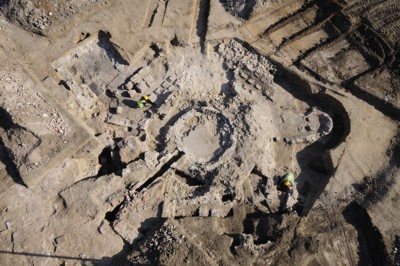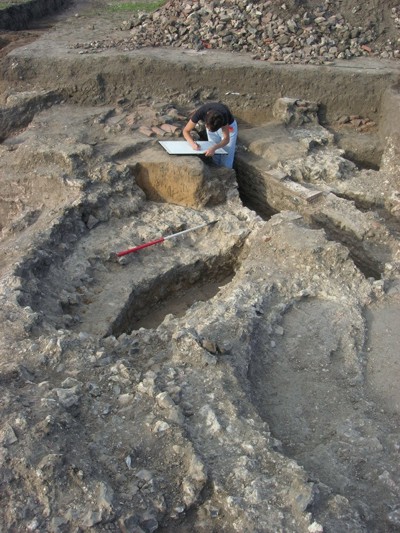Excavation at Bax Farm
The 2009 Summer Excavation of the Kent Archaeological Field School was to investigate a Roman octagonal building located as debris in a field at Bax Farm by Dr Paul Wilkinson as part of the Swale Archaeological Survey in 2000.
Eighty two students from most of the major universities in Britain had gathered for three weeks training and excavation at the end of which they exposed a large part of a unique and magnificent late Roman octagonal structure with a huge octagonal central plunge bath probably built at the time of Constantine, the first Christian Emperor.
 The blue coloured fresco floor of the plunge bath had still survived as had the Roman lead water pipe leading from the massive Roman brick arched conduit which carried copious amounts of water to the plunge bath.
The blue coloured fresco floor of the plunge bath had still survived as had the Roman lead water pipe leading from the massive Roman brick arched conduit which carried copious amounts of water to the plunge bath.
An earlier evaluation trench dug in 2006 had also revealed the concrete base of an enormous Roman corn mill, a huge 'hollow-way' road leading down from other Roman buildings, again revealed by geophysical survey, to a possible harbour. Earlier Iron-Age ditches and later Anglo-Saxon buildings all added to the rich repertoire of the site.
But the jewel in the crown is the unusual, and unique in South-East Britain, Roman octagonal bath house. The structure is about 14 metres across and has arcaded columns surrounding the huge at over 4 metres central octagonal pool. The walls of the building were originally covered with decorated painted plaster and the floors with smaller than usual tesserae in black, yellow, red and blue stone and tile. Smaller marble mosaic cubes were also retrieved which suggest that some of the floors may have had mosaics.
 Octagonal buildings of this type have only been found in the West Country at Lufton and Holcombe, others are further afield in Ravenna and Rome where their function is of early Christian baptisteries. The function of these elaborate and exotic buildings in Britain has often been discussed but most experts keep coming back to the idea that the astonishing octagonal frigidarium at the centre of the building could have been used for Christian baptism or even Jewish baptismal bathing, a scenario reinforced of the finding of a Roman lead seal at Bax Farm which probably is a "redemption of the first born" medal and depicts a special kind of five-branched menorah used in the ceremony of baptism.
Octagonal buildings of this type have only been found in the West Country at Lufton and Holcombe, others are further afield in Ravenna and Rome where their function is of early Christian baptisteries. The function of these elaborate and exotic buildings in Britain has often been discussed but most experts keep coming back to the idea that the astonishing octagonal frigidarium at the centre of the building could have been used for Christian baptism or even Jewish baptismal bathing, a scenario reinforced of the finding of a Roman lead seal at Bax Farm which probably is a "redemption of the first born" medal and depicts a special kind of five-branched menorah used in the ceremony of baptism.
The corpus of excavated pottery and coins suggests that the octagonal Roman building at Bax Farm was built during the reign of Constantine, and could be associated with his time in Britain where he was proclaimed Emperor on the death of his father at York.
It seems that this type of sophisticated and unusual building was introduced from the Eastern Roman Empire by Constantine, initially in Britain and then throughout the West Roman Empire purely as a building where large numbers of people could be baptised into the new state religion of the Roman Empire- Christianity. Some rooms at Bax Farm had underfloor heating as well as alcoves which contained hot plunge baths. Of particular interest is the discovery of an apse or schola set out of the perimeter of the octagon building on the south west side and enclosing a hypocaust hot room and the masonry base of a large cold water basin or labrum. It is logical to assume that above the central pool and its fountain was a vaulted ceiling carried on arcaded columns- some elements of a stucco ceiling have also survived- and a large dome set on pendentives pierced by clearstory lighting. The high building would have echoed and reflected the sound of cascading water on its blue domed ceiling.
Ceiling such as these would have been possible with the columns or arcading bearing the vertical pressure, and the surrounding ground floor room masonry wall dividers providing a buttressing effect to counteract the outward thrust of the tower. This is very sophisticated Roman engineering and belongs more to the world of the Eastern Roman Empire and has to open a discussion on why were such Roman influences prevalent in Roman Britain.
Dr Paul Wilkinson
14th September 2009